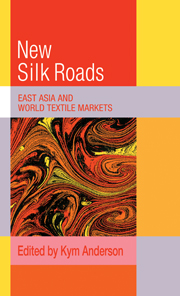Book contents
- Frontmatter
- Contents
- List of figures
- List of tables
- Contributors to this volume
- Preface
- Abbreviations and acronyms
- Symbols
- Introduction and summary
- I FIBRES, TEXTILES AND ECONOMIC DEVELOPMENT
- 1 The changing role of fibres, textiles and clothing as economies grow
- 2 The experience of Japan in historical and international perspective
- 3 Effects of China's dramatic reforms on its neighbours and on world markets
- 4 Thailand's growth in textile and clothing exports
- II DEMAND FOR TEXTILE EXPORTS FROM NEWLY INDUSTRIALIZING ASIA
- III CONCLUSIONS
- Appendix: Data on world production, consumption and trade in textiles, clothing and fibres
- Bibliography
- Index
2 - The experience of Japan in historical and international perspective
Published online by Cambridge University Press: 19 January 2010
- Frontmatter
- Contents
- List of figures
- List of tables
- Contributors to this volume
- Preface
- Abbreviations and acronyms
- Symbols
- Introduction and summary
- I FIBRES, TEXTILES AND ECONOMIC DEVELOPMENT
- 1 The changing role of fibres, textiles and clothing as economies grow
- 2 The experience of Japan in historical and international perspective
- 3 Effects of China's dramatic reforms on its neighbours and on world markets
- 4 Thailand's growth in textile and clothing exports
- II DEMAND FOR TEXTILE EXPORTS FROM NEWLY INDUSTRIALIZING ASIA
- III CONCLUSIONS
- Appendix: Data on world production, consumption and trade in textiles, clothing and fibres
- Bibliography
- Index
Summary
In recent decades producers of textiles and clothing in advanced industrial economies have been the first large group of manufacturers to come under pressure to decline as a result of import competition from newly industrializing economies (NIEs). The main reason for this phenomenon, as pointed out in the previous chapter, is that many processes in textile and clothing production tend to be intensive in the use of unskilled labour so, as unskilled labour becomes relatively scarce in the advanced economies, comparative advantage gradually moves to countries less well endowed with physical and human capital per worker. However, only a subset of countries with low capitallabour ratios are likely to become exporters of labour-intensive manufactures. The theory summarized in Chapter 1 suggests that subset is limited to NIEs that are poorly endowed with natural resources per worker and hence characterized by low real wages for labour attracted from primary production to industry, and whose stock of industrial capital per worker is expanding relatively rapidly from a low base. The increasing dominance of East Asia's resource-poor, rapidly growing economies in the growth of imports of textiles and clothing into the advanced industrial economies, as depicted in Table 1.5 above, is certainly consistent with that theory.
One of the purposes of this chapter is to show that this theory is also supported strongly by evidence provided over a much longer term by Japan's experience.
- Type
- Chapter
- Information
- The New Silk RoadsEast Asia and World Textile Markets, pp. 15 - 29Publisher: Cambridge University PressPrint publication year: 1992
- 1
- Cited by



